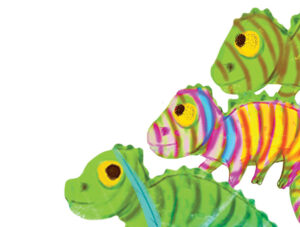

Scroll down for More About Diversity and Kindness
Chameleons are one of the most interesting and specialized lizards to learn about.
- Chameleons always have their eyes on you.
One eye can see an object looking in one direction while the other eye can point in a completely different direction and see something else! They can move their eyes independently.
- Their color change is not just a survival instinct.
Most people are under the impression that chameleons only change colors to blend in with their environment, but that’s not entirely the case, according to chameleon breeder Elan Miller. “A lot of people think if they put a chameleon on a color, they’ll change to it. That is a false rumor. They change color with mood,” Miller stated. The different color tones can also help regulate the chameleon’s body temperature.
- Chameleons’ tongues are their secret weapon.
Chameleons tongues can change speeds and directions more quickly than the fastest sports car, and their tongues can be up to 2 1/2 times as long as their body!
- Chameleons cannot regrow their tail.
Most lizards have the ability to regenerate a severed tail, but not chameleons. Their tail essentially acts like another limb and is not designed to be able to break off, so if it does they will, unfortunately, never have another.
- Chameleon spit is incredibly sticky.
Like a spider using its sticky web for prey, chameleons use their spit to coat the prey they catch with their tongues and pull them inwards to their mouth. Their spit is 400 times stickier than a human’s, according to ExoticDirect.
These 5 facts are just a few of the interesting things to learn about chameleons but there is still so much more to explore about the species.
Source: runneronline.com, Alexis Shofner, Staff writer
Facts About the Chameleon, Lisa Strattin
A picture book for kids with excellent photographs, and facts about chameleons from around the world.
Ages 5-8 years old
Jackson’s Chameleons as Pets, Jonathan Durham
Jackson’s classic chameleon book for the care, feeding, handling, health and common myths about these
fascinating reptiles.
Ages 9-adult

From the Dedication in Always Sam by Maya Angelou:
“In diversity, there is beauty and strength.”
What does diversity mean?
It means that there are differences among people. Some people look like you, talk like you, and act like you. Others are different from you, and different from one another. Some people have dark skin, some have light skin, some are tall, some short. People eat different food, dress differently. Some speak English, Spanish, French, Chinese, maybe an African language. There are over 7000 different languages spoken in our world!
Should we be afraid of differences? No.
We need to be curious, and get to know people. Just like Sam, people may be different on the outside, but on the inside, all people have a beating heart, and feelings. Everyone wants to have friends and be included.
Here are some books where you can learn more about diversity, differences, kindness, and friendship:
Our Diversity Makes Us Stronger, by Elizabeth Cole, for ages 3-6
If you want to teach your child to accept himself and others as they are, then this picture book about diversity will be your best assistant. It will help your little ones to respect all the differences that make us unique.
It’s OK to be Different: A Children’s Picture Book about Diversity and Kindness, Sharon Purtill, ages 2-6 yrs
Every child is unique! Whether they are big or small, short or talk, like to swim, dance, sing or bike. Perhaps they have a special need or disability, or have a different ethnic background. Readers get the message that we are all different in some ways and we all need to be kind to one another.
We All Belong, Natalie Goss, Alex Goss, ages 2-7
A fun board book about diversity for the very young. There’s rhyming text, peek-through pages, die cuts, and a shiny cloth rainbow at the end— just like Always Sam!
All Are Neighbors, Alexandra Penfold, Suzanne Kaufman, ages 4-8
When a new family moves in, the whole neighborhood comes together to celebrate their diverse community.
Children of the World, Nicola Edwards, ages 7-8
Young readers discover what life is like for children all around the world as they explore everything from food to family, and even learn how to say hello in different languages. They get important insights into the many differences to celebrate in our diverse, beautiful world.
What is a Friend and How Do I Possibly Make One?, Stephanie Chan, ages 5-8
This instructive and friendly book goes into the actual skills of making friends including greetings and empathy . It provides social situations where children can practice friendship making skills.The author effectively uses behavioral technologies like clear instructions, modeling, rehearsal and feedback.
Growing Friendships, Dr. Eileen Kennedy-Moore and Charistine McLaughlin, ages 6-9
Friendships aren’t always easy. Many kids struggle socially sometimes with arguments, teasing, and finding a new buddy. Sometimes it’s complicated. This friendship expert author addresses reaching out to make friends, stepping back to keep friends, blending in to join friends, speaking up to share with friends and letting go to accept friends.
“Growing up as the only Sikh Punjabi kid in a small town in Vermont, I felt the sting of isolation and the weight of judgment from other kids. Always Sam resonates deeply with me, as an individual and as a parent hoping for a kinder society for my kids. Joan crafts a tale that addresses the complexities of diversity while celebrating our unique differences. It’s a heartwarming beacon of hope and understanding. Always Sam is essential reading for both children and adults yearning for a more compassionate world.”
—RAJ SODHI, ENGINEER, MUSICIAN
